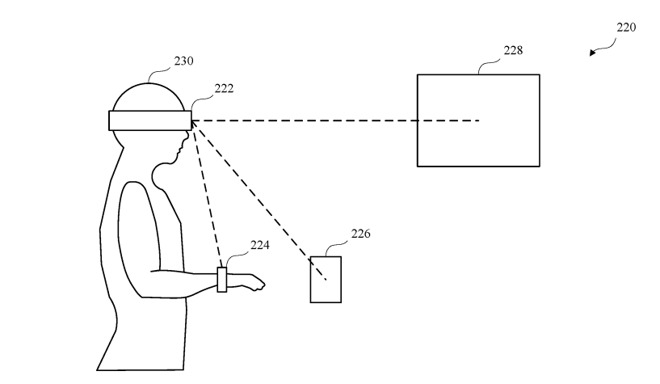
The Magic Leap One Lightwear AR goggles, an example of an AR headset
One of the problems users experience when they have multiple devices on hand is the need to authenticate each and every one of them. For example, a person may have to unlock an iPhone, an iPad, an Apple Watch, a Mac, and other computing devices multiple times in a day.
While Apple has attempted to cut down the time it takes to access some devices, such as with Face ID and Touch ID authentication, the process does still take some time to accomplish. Apple believes one answer to the problem may be authentication by proximity, a concept it already offers by allowing a Mac to unlock if a user's Apple Watch is nearby.
In a patent application titled "Authenticated Device Assisted User Authentication" published by the US Patent and Trademark Office on Thursday, Apple proposes expanding the idea to other hardware, in allowing the owner of an authenticated device access to restricted functions on another item.
In Apple's system, an authenticated device could take the form of a "head-mounted device," such as smart glasses or an AR or VR headset. For that device, the user is authenticated manually, and is granted a level of access to that device's functionality depending on how it is configured.

An illustration of an authenticated headset communicating with nearby devices to unlock them
A nearby device, like an iPhone or iPad, could be in a locked state by default, and would normally be inaccessible without authentication. The worn headset could use its proximity to the locked device to determine the intention of the user, which can prompt it to send authentication data to the locked item to identify the user.
Depending on how the locked device is configured, the authentication data could be used to unlock it, or to provide a limited set of functions pending a full unlocking procedure.
While proximity and intent can be determined by a number of ways, Apple's suggestion for the headset involves the use of image sensors capable of spotting the locked hardware, and in turn to determine its position relative to the user for intent analysis. This could feasibly be done using other sensors in concert, such as with ultrawide-band radios.
Depending on the detected intent of the user, it is possible the headset could send a second authentication transmission to an unlocked device, telling it to lock back up. While this could help keep a user's data more secure by eliminating the need for a device to time out, it also helps correct instances where the headset unlocks a nearby device that it thinks will be used, but ultimately does not.
Apple files numerous patent applications on a weekly basis, but while the existence of a patent indicates areas of interest for the company's research and development efforts, they do not guarantee the existence of a product or service using the concept in the future.
The patent filing lists its inventors as Fletcher R. Rothkopf, Arlen M. Hartounian, Grant H. Mulliken, and James W. VanDyke.
Apple's AR and VR headset has been long-rumored, but yet to launch as a device. This hasn't stopped it from appearing in many different patents, such as February's filing for a headset that doesn't require external markers to tell a user is moving.
There have also been filings in relation to hidden headset cameras, removable earphones, and holographic imaging, among other ideas.
https://appleinsider.com/articles/20/02/27/apples-ar-headset-or-smart-glasses-may-unlock-your-iphone-automatically
2020-02-27 12:01:54Z
CAIiENZvB7XeM9XXneL8W5NsDowqFQgEKg0IACoGCAow9ckFMIBVMJCfBA
Bagikan Berita Ini















0 Response to "Apple's AR headset or smart glasses may unlock your iPhone automatically - AppleInsider"
Post a Comment